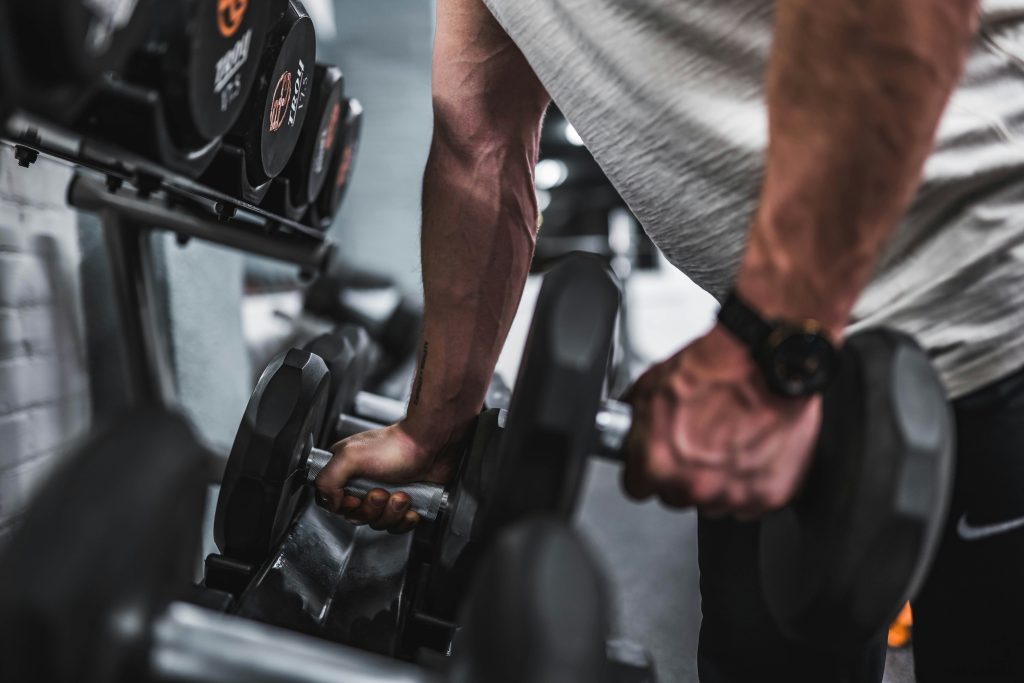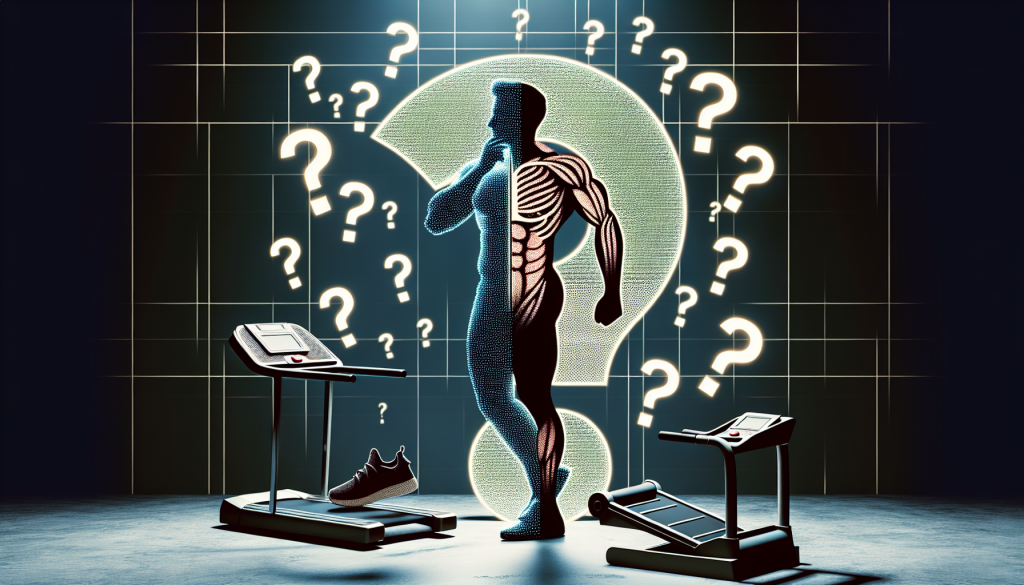If you’ve ever been on a quest for a chiseled physique, chances are you’ve asked yourself this question at some point: is it necessary to do cardio to get a ripped body? We all desire those six-pack abs and strong core muscles, but does it all come down to pounding the pavement or spending hours on a treadmill? Join us as we explore this common query and shed some light on the role of cardio in achieving your fitness goals.

Potential Benefits of Cardio for Getting a Ripped Body
Boosts calorie burn
When it comes to achieving a ripped body, calorie burn plays a crucial role. Cardio exercises can significantly boost your calorie burn, which in turn can contribute to fat loss and muscle definition. Engaging in cardiovascular activities such as running, biking, or swimming can elevate your heart rate and increase your metabolic rate. This increased calorie burn can create a calorie deficit, prompting your body to utilize stored fat for energy.
Reduces body fat percentage
One of the primary goals in achieving a ripped body is to reduce body fat percentage. Cardiovascular exercises, when combined with a healthy diet, can aid in shedding excess body fat. By engaging in regular cardio workouts, you can effectively burn calories and reduce overall body fat, revealing the defined muscles underneath. Remember, however, that spot reduction is a myth, and fat loss occurs throughout your entire body, not just in specific areas.
Increases cardiovascular endurance
Cardiovascular endurance, also known as aerobic fitness or stamina, is the ability of your heart and lungs to supply oxygen-rich blood to your muscles during physical activity. Regular cardio training can significantly improve your cardiovascular endurance, allowing you to work out for longer durations without feeling fatigued. This increased endurance can be beneficial for various activities, whether it’s an intense weightlifting session or performing everyday tasks with ease.
Improved insulin sensitivity
Cardio exercises have been found to enhance insulin sensitivity, which is the body’s ability to efficiently utilize carbohydrates and regulate blood sugar levels. By improving insulin sensitivity, your body becomes more efficient at transporting glucose into muscle cells, where it can be stored as glycogen for energy. This can lead to better post-workout recovery, improved muscle growth, and a reduced risk of metabolic disorders such as type 2 diabetes.
The Role of Cardio in Muscle Definition
Cardiovascular exercise and muscle definition
While cardio exercises are commonly associated with burning calories and reducing body fat, they also play a vital role in muscle definition. When you engage in cardiovascular activities, you not only burn calories but also stimulate the muscles in your body. Endurance-based exercises like running or cycling require your muscles to contract repeatedly, promoting muscle growth and toning. This increased muscle mass, coupled with reduced body fat, enhances the visibility of your muscles, resulting in a ripped physique.
Cardio’s impact on muscle visibility
Cardio exercises can contribute to muscle visibility in several ways. Firstly, by reducing overall body fat, cardio workouts can unveil the underlying muscle definition. As your body fat percentage decreases, the muscles become more prominent and defined. Additionally, cardio exercises improve blood circulation, delivering essential nutrients and oxygen to your muscles. This improved blood flow aids in post-workout recovery and muscle growth, further enhancing muscle visibility.
Balancing Cardio and Strength Training for Optimal Results
Finding the right combination
To achieve optimal results when aiming for a ripped body, it is essential to find the right balance between cardio and strength training. While cardio exercises contribute to fat loss and muscle definition, strength training plays a crucial role in building lean muscle mass. Incorporating both types of exercises into your routine can help you achieve a balanced physique. The specific ratio of cardio to strength training may vary depending on individual goals and preferences.
The importance of progressive overload
Incorporating progressive overload into your strength training routine is crucial for muscle development. Progressive overload involves gradually increasing the intensity, volume, or frequency of your workouts over time to continue challenging your muscles. While cardio exercises should be a part of your routine, it is important not to neglect the progressive overload principle in strength training. By continuously challenging your muscles, you stimulate growth and maximize muscle definition.
Considerations for workout schedule
When balancing cardio and strength training, it’s important to consider your workout schedule. While some individuals prefer alternating cardio and strength training days, others prefer combining both types of exercises in the same session. Experiment with different approaches to find what works best for you. However, be mindful of allowing sufficient rest and recovery between workouts to avoid overtraining and promote muscle growth.
Effective Cardio Exercises for a Ripped Body
High-intensity interval training (HIIT)
High-intensity interval training, commonly known as HIIT, is a popular cardio exercise technique that involves short bursts of intense exercise followed by brief recovery periods. HIIT workouts are time-efficient and highly effective for burning calories, boosting metabolism, and promoting fat loss. These exercises can be customized to your fitness level and can include activities such as sprinting, cycling, or bodyweight exercises. Incorporating HIIT into your routine can help you achieve a ripped body by maximizing calorie burn and promoting muscle definition.
Circuit training
Circuit training combines cardiovascular exercises with strength training in a high-intensity format. This form of exercise involves performing a series of exercises back-to-back with minimal rest in between. By incorporating compound exercises that target multiple muscle groups, circuit training can help you burn calories, build strength, and improve cardiovascular fitness simultaneously. This comprehensive approach can contribute to a well-rounded and ripped physique.
Sprint intervals
Sprint intervals are a powerful cardio exercise for developing a toned and ripped body. Sprinting involves running at maximum effort for short distances, followed by recovery periods. This form of exercise not only burns calories but also engages multiple muscle groups, promoting muscle definition. Incorporating sprint intervals into your routine can help improve your cardiovascular fitness, increase calorie burn, and enhance leg muscle development.
Jumping rope
Jumping rope may seem simple, but it is a highly effective cardio exercise for achieving a ripped body. Not only does it burn a significant amount of calories, but it also engages multiple muscle groups, including your legs, core, and upper body. Jumping rope can improve cardiovascular endurance, coordination, and agility, while also contributing to muscle definition in your calves, thighs, and shoulders. This versatile exercise can be easily incorporated into your routine, whether at home or at the gym.

Alternatives to Traditional Cardio
Weightlifting for calorie burn
While traditional cardiovascular exercises are effective for burning calories, weightlifting can also have a significant impact on calorie burn. Strength training exercises, especially compound movements like squats, deadlifts, and bench presses, require a considerable amount of energy and can elevate your heart rate. This increased energy expenditure not only contributes to calorie burn during the workout but also stimulates muscle growth and definition. Incorporating weightlifting into your routine provides a unique and effective alternative to traditional cardio exercises.
Plyometric exercises for cardiovascular benefits
Plyometric exercises, also referred to as jump training, are dynamic movements that involve explosive muscle contractions. These exercises, such as box jumps, burpees, or squat jumps, not only improve explosive power and strength but also provide significant cardiovascular benefits. Plyometric exercises increase heart rate and engage large muscle groups, promoting fat loss while simultaneously enhancing muscular power and definition. Adding plyometric exercises to your routine can add variety and intensity to your cardiovascular training.
Calisthenics for muscle building and conditioning
Calisthenics, a form of bodyweight training, can provide both cardiovascular benefits and muscle building potential. Calisthenic exercises like push-ups, pull-ups, and squats require significant effort, engaging your muscles and increasing heart rate. The combination of strength training and cardiovascular exercise within calisthenics can lead to enhanced muscle definition and overall conditioning. Incorporating calisthenics movements into your routine can offer an effective alternative or complement to traditional cardio exercises.
Common Misconceptions about Cardio and Getting Ripped
Overemphasis on cardio and neglecting strength training
One common misconception when aiming for a ripped body is to focus solely on cardio exercise and overlook the importance of strength training. While cardio exercises contribute to fat loss and cardiovascular health, strength training is crucial for building and maintaining lean muscle mass. Neglecting strength training can hinder the development of a well-defined physique. To achieve a ripped body, it is essential to strike a balance between cardio and strength training to maximize fat loss and muscle definition.
Spot reduction myth
Another misconception is the belief in spot reduction, which suggests that targeting specific areas of the body with exercise can solely burn fat in those areas. Unfortunately, spot reduction is not supported by scientific evidence. Fat loss occurs throughout the entire body when a calorie deficit is achieved, and it is not possible to target fat loss in specific regions. Cardio exercises contribute to overall fat loss, which may ultimately reveal the muscle definition underneath, but it is important to approach fat loss holistically rather than trying to spot reduce.
Lack of understanding about nutrition
Proper nutrition plays a vital role in achieving a ripped body. Some individuals believe that they can rely solely on cardio exercises to burn calories and achieve their desired physique, neglecting the importance of a well-balanced diet. Without adequate nutrition, your body may not have the necessary fuel to support muscle growth and recovery. It is crucial to prioritize nutrient-dense foods, maintain a calorie deficit if fat loss is the goal, and ensure sufficient protein intake to support muscle development and definition.

Importance of a Balanced Diet for Building a Ripped Body
Role of nutrition in muscle development
When striving for a ripped body, nutrition is of utmost importance. Your body needs the proper nutrients, vitamins, and minerals to support muscle development and definition. A well-balanced diet rich in lean protein, complex carbohydrates, and healthy fats provides the necessary building blocks for muscle growth and repair. Adequate nutrition ensures that you have the energy and nutrients to fuel your workouts effectively and recover optimally.
Optimizing protein intake
Protein is an essential macronutrient for building and repairing muscle tissue. It is recommended to consume an adequate amount of protein to support muscle growth and recovery, especially when aiming for a ripped body. Good sources of protein include lean meats, fish, eggs, dairy products, legumes, and plant-based options like tofu or tempeh. Incorporating protein-rich foods into your meals and snacks can help optimize protein intake and support muscle development.
Incorporating healthy fats and carbohydrates
While protein is crucial for muscle development, it is equally important to include healthy fats and carbohydrates in your diet. Healthy fats, found in foods like avocados, nuts, and olive oil, provide essential fatty acids that support hormone production and aid in nutrient absorption. Complex carbohydrates, such as whole grains, fruits, and vegetables, provide sustained energy for workouts and help replenish glycogen stores. Balancing your macronutrient intake according to your individual needs and goals is key for building a ripped body.
Personalization and Individual Factors in Cardio Training
Considering individual goals and preferences
When incorporating cardio training into your fitness routine, it is important to consider your personal goals and preferences. Some individuals may enjoy long-distance running or cycling, while others may prefer short and intense HIIT workouts. Understanding what type of cardio you enjoy and aligning it with your goals can help improve adherence and overall satisfaction with your workouts. Personalization is key to maintaining consistency and achieving the desired results.
Differences in body types and metabolism
It is essential to recognize that different individuals have varying body types and metabolisms, which can impact their response to cardio training. While some people may naturally have a higher metabolic rate and respond well to intense cardio workouts, others may find that combining cardio with strength training yields better results. Being mindful of your body’s unique characteristics and adjusting your cardio training accordingly can help optimize your progress and maximize your potential for a ripped body.

Incorporating Cardio into Your Fitness Routine
Gradual introduction of cardio exercises
If you are new to cardio training or have not engaged in regular cardio workouts, it is essential to introduce them gradually into your fitness routine. Sudden high-intensity or high-volume cardio sessions can put excessive stress on your body and increase the risk of injury. Begin by incorporating shorter sessions of cardio exercise a few times per week and gradually increase the duration and intensity as your fitness level improves. This gradual progression allows your body to adapt and reduces the likelihood of overexertion.
Frequency and duration of cardio sessions
The frequency and duration of your cardio sessions depend on your goals, fitness level, and individual preferences. For general cardiovascular health, the American Heart Association advises adults to engage in at least 150 minutes of moderate-intensity aerobic activity or 75 minutes of vigorous-intensity activity per week. However, when aiming for a ripped body, you may need to increase the frequency and intensity of your cardio workouts. Strive for a balance that allows you to achieve your desired results while considering the importance of rest and recovery.
Conclusion
Incorporating cardio exercises into your fitness routine can be highly beneficial when striving for a ripped body. The potential benefits of cardio include boosting calorie burn, reducing body fat percentage, improving cardiovascular endurance, and enhancing insulin sensitivity. Cardio exercises play a multifaceted role in muscle definition by promoting fat loss, stimulating muscle growth, and increasing muscle visibility. Balancing cardio with strength training, choosing effective cardio exercises, and considering individual factors are key to achieving optimal results. Additionally, understanding common misconceptions, prioritizing nutrition, personalizing your training, and gradually incorporating cardio can contribute to building a ripped body. Remember, achieving a ripped body requires consistency, dedication, and a holistic approach encompassing both exercise and nutrition.






